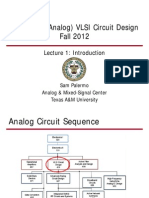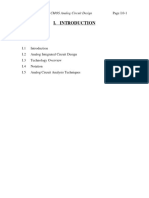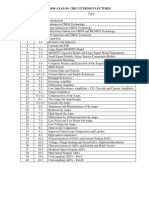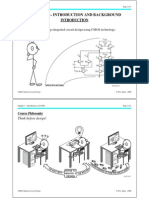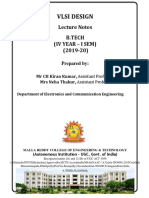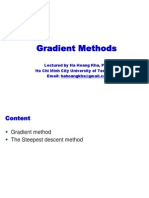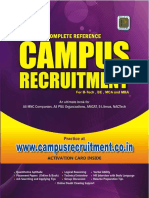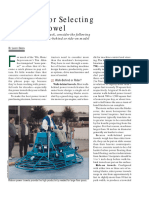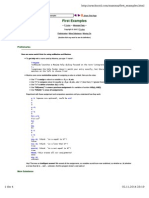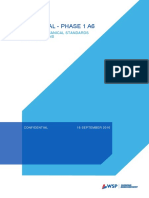CMOS ANALOG IC DESIGN
Spring 2013
Dr. Cuong Huynh
cuonghpm@yahoo.com
Department of Telecommunications Faculty of Electrical and Electronics Engineering Ho Chi Minh city University of Technology
Dr. Cuong HuynhTelecommunications DepartmentHCMUT 1
�CMOS ANALOG IC DESIGN
Spring 2013
Instructor: Cuong Huynh (Ph.D) Office: 114 B3 Office Hours: Friday 2:00-4:00 PM Phone: 0915 592 622 E-mail: cuonghpm@yahoo.com Textbook: [1] Design of Analog CMOS Integrated Circuits, B. Razavi, McGraw-Hill, 2001. References: [2] Analog Integrated Circuit Design, D. Johns and K. Martin, John Wiley & Sons, 1997. [3] Analysis and Design of Analog Integrated Circuits, P. Gray, R. Meyer, P. Hurst, and S. Lewis, John Wiley and Sons, 4th Edition, 2003. [4] Technical Papers
Dr. Cuong HuynhTelecommunications DepartmentHCMUT 2
�CMOS ANALOG IC DESIGN
Spring 2013
Objectives:
Understand CMOS technology from a design perspective Discuss basic transistor models and layout techniques for design and characterization of analog integrated circuits. Study the most important building blocks in CMOS technologies and understand their advantages and limitations. Learn analog CMOS design approaches: Specification Circuit Topology Circuit Simulation Layout Fabrication Design basic analog IC circuits considering practical parameters. Use the IC design tools, especially Cadence, Spectre, Spice, 3 and Matlab. Dr. Cuong HuynhTelecommunications DepartmentHCMUT
�CMOS ANALOG IC DESIGN
Spring 2013
GRADING: Final Exams: 60% Closed book One double sided 8.5x11 note sheet allowed Homework :10% You are encouraged to work together with your colleagues on the homework. However, each student must turn in an independent write-up. No late homework will be graded Laboratory 20% Final Project 10% Report and PowerPoint presentation required
Dr. Cuong HuynhTelecommunications DepartmentHCMUT 4
�CMOS ANALOG IC DESIGN
Spring 2013
OutLine: Chapter 1: Introduction Chapter 2: MOS Transistor Characteristics and Modeling Chapter 3: Single-stage Amplifier Chapter 4: Differential Amplifier Chapter 5: Current Mirror Chapter 6: Frequency Response of Amplifiers Chapter 7: Noise Chapter 8: Feedback Chapter 9: Operational Amplifier Chapter 10: Stability and Frequency Compensation Chapter 11: Bandgap References
Dr. Cuong HuynhTelecommunications DepartmentHCMUT 5
�CMOS ANALOG IC DESIGN
Spring 2013
Lecture 1: Introduction
Dr. Cuong Huynh
cuonghpm@yahoo.com Department of Telecommunications Faculty of Electrical and Electronics Engineering Ho Chi Minh city University of Technology
Dr. Cuong HuynhTelecommunications DepartmentHCMUT 6
�Why is Analog Important?
Naturally occurring signals are analog Analog circuits are required to amplify and condition the signal for further processing Performance of analog circuits often determine whether the chip works or not Examples Sensors and actuators (imagers, MEMS) Optical receiver, RF transceivers Microprocessor circuits (PLL, high-speed I/O, thermal sensor)
Dr. Cuong HuynhTelecommunications DepartmentHCMUT 7
�Why Integrated?
What is Integrated Circuits ? Why Integrated ? Smaller size, reduced cost, increased performance. Motivate creativity and new applications: RFID, sensor . . . Idea of integration was in the late 1950s. Prediction of Gordon Moore (one of Intel founder).
Dr. Cuong HuynhTelecommunications DepartmentHCMUT
�Why Integrated?
Dr. Cuong HuynhTelecommunications DepartmentHCMUT
�Why CMOS?
The metaloxidesemiconductor field-effect transistor (MOSFET) was first patented by Julius Edgar Lilienfeld in 1925, well before the invention of BJT. Due to the fabrication limitation, MOSFET has not been used until the early years of 1960s. CMOS (Complementary MOS p- and n-type device) was patented by Frank Wanlass in 1967, initiating a revolution in the semiconductor industry. CMOS initially dominates in the digital circuit/systems while others for analog. Why CMOS now ? Low cost, high integration and solution for SOC.
Dr. Cuong HuynhTelecommunications DepartmentHCMUT
10
�CMOS Technology Overview
CMOS Transistors Interconnect Diodes Resistors Capacitors Inductors Bipolar Transistors
Dr. Cuong HuynhTelecommunications DepartmentHCMUT
11
�CMOS Technology Overview
Transistors
Dr. Cuong HuynhTelecommunications DepartmentHCMUT
12
�CMOS Technology Overview
NMOS Transistor
Dr. Cuong HuynhTelecommunications DepartmentHCMUT
13
�CMOS Technology Overview
PMOS Transistor
Dr. Cuong HuynhTelecommunications DepartmentHCMUT
14
�CMOS Technology Overview
Interconnect
Dr. Cuong HuynhTelecommunications DepartmentHCMUT
15
�CMOS Technology Overview
Diode
Dr. Cuong HuynhTelecommunications DepartmentHCMUT
16
�CMOS Technology Overview
Resistor
Dr. Cuong HuynhTelecommunications DepartmentHCMUT
17
�CMOS Technology Overview
Capacitor
Dr. Cuong HuynhTelecommunications DepartmentHCMUT
18
�CMOS Technology Overview
Inductor
Dr. Cuong HuynhTelecommunications DepartmentHCMUT
19
�CMOS Technology Overview
Vertical PNP BJT
Dr. Cuong HuynhTelecommunications DepartmentHCMUT
20
�CMOS Technology Overview
Latchup
Dr. Cuong HuynhTelecommunications DepartmentHCMUT
21
�CMOS Technology Overview
Read Appendix B, Razavis Book
Dr. Cuong HuynhTelecommunications DepartmentHCMUT
22
�Analog IC Design Process
Dr. Cuong HuynhTelecommunications DepartmentHCMUT
23
�Analog IC Design Process
Dr. Cuong HuynhTelecommunications DepartmentHCMUT
24
�Analog IC Design Process
Dr. Cuong HuynhTelecommunications DepartmentHCMUT
25
�Analog IC Design Process
Dr. Cuong HuynhTelecommunications DepartmentHCMUT
26
�Analog IC Design Process
Chip Microphotograph (4.4mm x 2mm)
Dr. Cuong HuynhTelecommunications DepartmentHCMUT
27
�Analog IC Design Process
Dr. Cuong HuynhTelecommunications DepartmentHCMUT
28
�Analog IC Design Process
Small-outline integrated circuit (SOIC) QFN (quad-flat no-leads) Dual in-line package (DIP Wafer-level packaging (WLP) Chip Scale Package (CSP) QFP or Quad Flat Package
Dr. Cuong HuynhTelecommunications DepartmentHCMUT
29
�Analog IC Design Process
Dr. Cuong HuynhTelecommunications DepartmentHCMUT
30
�ANALOG IC DESIGN SKILLSET
Characteristics of Analog Integrated Circuit Design
Done at the circuits level Complexity is high Continues to provide challenges as technology evolves Demands a strong understanding of the principles, concepts and techniques Good designers generally have a good physics background Requires a good grasp of both modeling and technology Have a wide range of skills - breadth (analog only is rare) Be able to learn from failure Be able to use simulation correctly
Dr. Cuong HuynhTelecommunications DepartmentHCMUT
31
�ANALOG IC DESIGN SKILLSET
Dr. Cuong HuynhTelecommunications DepartmentHCMUT
32
�ANALOG IC DESIGN SKILLSET
Implications of Advanced Technology on IC Design The good: Smaller geometries Smaller parasitics Higher transconductance Higher bandwidths The bad: Reduced voltages Smaller channel resistances (lower gain) More nonlinearity Deviation from square-law behavior The challenging: Increased substrate noise in mixed signal applications Threshold voltages are not scaling with power supply Reduced dynamic range Poor matching at minimum channel length
Dr. Cuong HuynhTelecommunications DepartmentHCMUT 33
�ANALOG IC DESIGN SKILLSET
Dr. Cuong HuynhTelecommunications DepartmentHCMUT
34
�ANALOG IC DESIGN SKILLSET
Complexity in Analog Design Analog design is normally done in a non-hierarchical manner and makes little use of repeated blocks. As a consequence, analog design can become quite complex and challenging.
Dr. Cuong HuynhTelecommunications DepartmentHCMUT
35
�Analog IC Applications
Digital-analog and analog-digital conversion Disk drive controllers Modems - filters Bandgap reference Analog phase lock loops DC-DC conversion Buffers Codecs Wireless tranceivers Etc.
Current reading: Chapter 1 and Appendix B chap 16 in Razavis Book [1]
Dr. Cuong HuynhTelecommunications DepartmentHCMUT 36
�Next Time
Chapter 2: MOS Transistor Characteristics and Modeling MOS Transistor Modeling Threshold Voltage, VT DC I-V Equations Body Effect Subthreshold Region Reading: Chapter 2 and Appendix A in Razavis Book [1]
Dr. Cuong HuynhTelecommunications DepartmentHCMUT
37



